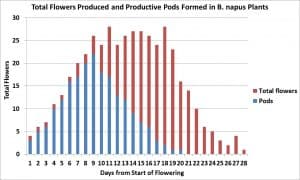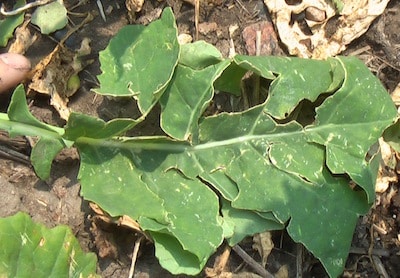Hail on 4- to 6-leaf plants: The later hail occurs, the higher the chance of yield loss, given that the plants have less time to recover. Plants at the 6-leaf stage, for example, that lose most of the leaf area on the main stem can still live, but these leaves will not regrow. The plant will be delayed, and more of the yield potential — which will be lower than before the hail — will come from side branches.
Hail at flowering: The later that hail occurs in the season, the more damage it can do to yield. That said, flowering canola can, with enough time, recover from hail that knocks off a large percentage of flowers. Canola will flower for longer to compensate. In light hail, canola can sometimes over-compensate and produce even higher yield. In serious hail situations where entire flowering branches are knocked off, plants that are still actively flowering can produce new branches. This will set back maturity, but with enough season left, these new branches can produce a decent yield.

What is the point of no return? Can a canola crop recover from almost complete destruction of above-ground growth? We’d like your help in answering that question. What’s the worst-damage/most-surprising-recovery situation you’ve seen? You can reply to this @CanolaWatch tweet or use the “Ask a question” form to share your experiences.

Rescue treatments for hail. There is no evidence that foliar nutrition or fungicides will help the recovery. However, we do know that crops hailed at the 4- to 6-leaf stage or earlier can get more blackleg. Fungicide might help, but use it only if you were considering using it in the first place. If the field was already at high risk of blackleg, hail damage increases that risk. If blackleg was not a major risk, fungicide probably won’t help much. Blackleg lesions on leaves or pseudothecia on canola residue are indicators of risk. If the variety is susceptible to the blackleg race(s) present, then the risk of yield loss is elevated.
A top dress of nitrogen fertilizer may compensate for nitrogen lost through hail-shredded leaves, but keep in mind that the yield potential of the crop is also lower — so the question is how much more do you want to invest in this crop?
Time and moisture are the best treatments for flowering canola. These will get the plant regrowing from its well-established root system. In a hail study at Fort Saskatchewan, Alberta, there was a response to fungicide applied once the flowering resumed AND when the crop recovered enough to have good yield potential. This response may have occurred because moisture that came with the hail increased sclerotinia spore release and canopy moisture. Growers applying a rescue treatment are encouraged to leave multiple check strips and compare yields for treated and untreated strips. Multiple strips are important in this case given the spotty nature of hail. Using one strip or applying treatment to half the field may not provide an accurate comparison.
If hail occurs during flowering, growers should wait until the crop comes back into flower and re-scout for sclerotinia risk before making a spray decision.

